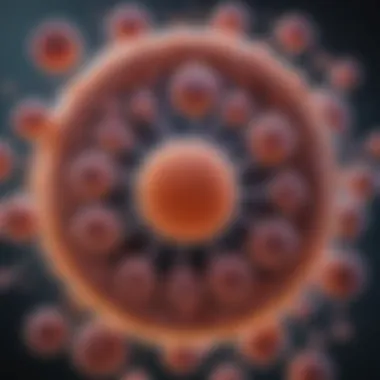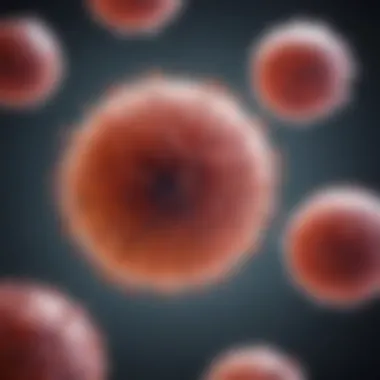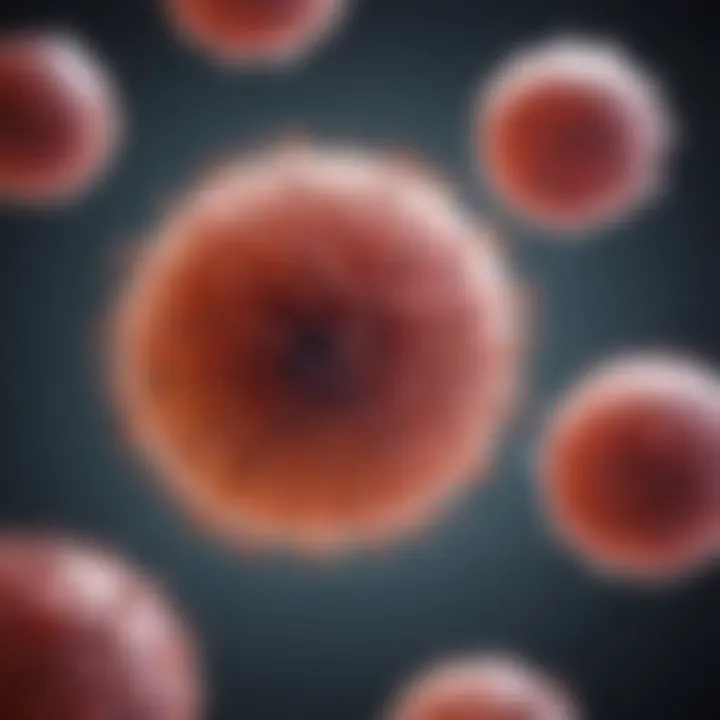Exploring Stem Cell Generation: Science and Ethics


Intro
Stem cell generation represents a remarkable frontier in biological research and medicine. It encompasses various methodologies and applications aimed at harnessing the potential of stem cells to treat diverse diseases and conditions. From embryonic stem cells to induced pluripotent stem cells (iPSCs), each source offers unique possibilities and challenges in scientific exploration. This section initiates a thorough examination of the subject, providing an overview of its critical aspects.
Overview of Research Topic
Brief Background and Context
Stem cells have a fascinating ability to differentiate into various cell types, making them invaluable for regenerative medicine. The journey of stem cell research began with the discovery of embryonic stem cells in the late 20th century. Over the years, advancements have taken place, bringing forth techniques such as SCNT and iPSCs. These innovations have reshaped our understanding of cellular development and opened pathways to potentially curative therapies.
Importance in Current Scientific Landscape
The relevance of stem cell generation cannot be overstated. It holds promise for treating ailments ranging from genetic disorders to degenerative diseases. In addition, the ongoing research propels discussions around ethics, regulatory practices, and societal implications. These factors make stem cell generation a vital area for current and future scientific endeavors.
Methodology
Research Design and Approach
The approach to studying stem cell generation involves a mix of both experimental and observational methods. Researchers conduct in vitro experiments to isolate and manipulate stem cells, utilizing CRISPR technologies among other techniques. They aim to understand the underlying mechanisms of stem cell differentiation and self-renewal.
Data Collection Techniques
Data collection encompasses a variety of techniques, such as:
- Genomic sequencing to analyze genetic material.
- Flow cytometry for cell sorting and analysis.
- Immunofluorescence to visualize specific cell types.
These methodologies enable a comprehensive understanding of stem cell behavior and enhance the potential for therapeutic applications.
"The pursuit of understanding stem cells is not merely a scientific challenge; it embodies the hopes for curing previously untreatable conditions."
This engaging narrative sets the stage for a thorough investigation into stem cell generation, focusing on essential components that underscore its complexity and significance.
Prelude to Stem Cells
In the realm of biology, stem cells are foundational elements that hold considerable potential for various fields, especially medicine. Their ability to differentiate into various cell types makes them invaluable for treating a range of diseases and injuries. This section emphasizes the critical role that stem cells play in both research and therapeutic settings.
Definition and Classification
Stem cells are unique cells characterized primarily by their ability to self-renew and differentiate into specialized cell types. They can be classified into two main categories: embryonic and adult stem cells.
- Embryonic Stem Cells: These cells are derived from the inner cell mass of a blastocyst. They are pluripotent, meaning they can develop into any cell type of the body.
- Adult Stem Cells: Found in various tissues, these cells are multipotent. They can only become a limited range of cell types related to their tissue of origin, such as hematopoietic stem cells that form various blood cells.
In addition to these, there are also induced pluripotent stem cells (iPSCs), which are adult cells reprogrammed to an embryonic-like state. This capability expands their potential uses in regenerative medicine. This classification is essential for understanding both the applications and limitations of different stem cell types in clinical settings.
Significance in Medicine
The significance of stem cells in medicine cannot be overstated. They offer possibilities for regenerative therapies and drug testing, addressing conditions previously deemed untreatable. Some benefits include:
- Regenerative capabilities: Stem cells can replace damaged cells, enhancing tissue repair and regeneration.
- Disease modeling: They allow researchers to better understand diseases by studying disease progression in vitro.
- Drug development: Testing drugs using stem cells can offer insights into their safety and efficacy before clinical trials.
"Stem cells represent a paradigm shift in the treatment of diseases that affect various layers of the human body, from blood disorders to neurological diseases."
Challenges still exist, such as ethical considerations and public perception, but ongoing research continues to highlight their immense potential. The various types and applications of stem cells lay the groundwork for advancements that could significantly improve health care outcomes.
Types of Stem Cells
Understanding the different types of stem cells is essential in the exploration of stem cell generation. Each type has its characteristics, functions, and potential applications in medicine. This section will detail the three main categories of stem cells: embryonic stem cells, adult stem cells, and induced pluripotent stem cells (iPSCs). Each type offers unique benefits and considerations, highlighting their significance in both research and therapeutic contexts.
Embryonic Stem Cells
Embryonic stem cells are derived from the inner cell mass of the blastocyst, an early-stage embryo. These cells are characterized by their pluripotency, meaning they can differentiate into almost any cell type in the human body. This ability makes them invaluable for a variety of applications, particularly in regenerative medicine.


The potential of embryonic stem cells is immense. They can be used to model diseases, test drug responses, and develop new therapies. However, their use has sparked ethical debates, primarily related to the moral status of human embryos. As such, regulations and ethical guidelines govern their research and application, making the conversation around their use both complex and essential.
Adult Stem Cells
Adult stem cells, also known as somatic stem cells, exist in various tissues and are typically multipotent, limiting them to differentiate into a limited range of cell types. They play a crucial role in maintaining and repairing the tissues in which they reside. Adult stem cells are found in numerous locations, including bone marrow, adipose tissue, and the brain.
These cells are celebrated for their potential in regenerative therapies, particularly for conditions affecting the blood or those requiring stable cell replacement. While they are less versatile than embryonic stem cells, adult stem cells are often more ethically acceptable. The low risk of tumor formation and rejection makes them a preferred choice in several therapeutic settings.
Induced Pluripotent Stem Cells (iPSCs)
Induced pluripotent stem cells are a breakthrough in stem cell research. Researchers can convert differentiated cells back into a pluripotent state through specific reprogramming techniques. This process allows adult cells, such as skin or blood cells, to regain the ability to develop into almost any cell type.
The creation of iPSCs presents substantial benefits in the field of medicine. These cells can be generated from a patient’s own tissues, significantly reducing the risks of rejection and ethical concerns linked to embryonic stem cells. Their potential applications range from basic research to complex regenerative therapies, offering a versatile platform for exploring disease mechanisms and developing personalized medicine approaches.
In summary, comprehending the types of stem cells is vital for grasping their implications in research and therapy. Each type, whether embryonic, adult, or induced pluripotent stem cells, carries distinct attributes and relevance within the scientific community.
Technologies for Stem Cell Generation
Stem cell generation is at the forefront of regenerative medicine. The advancements in technologies for generating stem cells play a crucial role in understanding diseases and developing therapies. Each method brings its unique advantages and limitations. By examining these technologies, one can appreciate their impact on both basic science and clinical applications.
Somatic Cell Nuclear Transfer (SCNT)
Somatic cell nuclear transfer is a technique where the nucleus of a somatic cell is transferred into an enucleated oocyte. This procedure can create an embryo that is genetically identical to the donor. The process has implications for therapeutic cloning and can potentially generate patient-specific stem cells.
The key aspects of this technology include its potential for regenerative medicine, as it allows for the creation of tailored stem cells for individual patients. However, SCNT faces considerable challenges. One major issue is the efficiency of the procedure. Most attempts at SCNT result in embryos that do not develop properly.
Moreover, there are significant ethical implications regarding cloning practices. Because of these factors, SCNT remains a topic of debate in both scientific and public discussions. While promising, it requires further research to address both its technical and ethical challenges.
Reprogramming Techniques for iPSCs
Induced pluripotent stem cells (iPSCs) represent a groundbreaking advancement in stem cell technology. By reprogramming somatic cells to revert to a pluripotent state, researchers can create stem cells that possess the ability to differentiate into any cell type. This method typically involves the introduction of specific transcription factors into the target cells.
The key benefit of iPSCs is their versatility. They can come from various tissues, making them widely accessible. They allow for personalized medicine approaches, as scientists can generate patient-specific cell lines to study diseases and test drugs.
However, reprogramming techniques still face hurdles. Some methods can integrate the gene delivery system into the host genome, raising safety concerns about tumor formation. Continuous advancements and optimization of these techniques will be necessary for future applications.
Genome Editing Approaches
Genome editing technologies, such as CRISPR-Cas9, have introduced new possibilities in stem cell research. These techniques enable precise modifications in the genetic material of stem cells. By correcting genetic mutations, researchers can use these approaches to model diseases accurately and explore new treatments.
The advantages of genome editing are clear. It offers a level of specificity and efficiency that was not previously possible. Researchers can achieve targeted alterations that can help understand gene functions in stem cells. Additionally, modifying iPSCs could enhance their therapeutic potential.
However, challenges remain. Off-target effects, where unintended parts of the genome are affected, pose risks that need addressing. The ethical considerations surrounding genetic modifications must also be carefully navigated. As these technologies evolve, their integration into stem cell research will likely become more prevalent, contributing to the field's growth.
"The future of stem cell generation lies not only in innovative techniques but also in addressing the ethical implications and safety concerns of these technologies."
In summary, the technologies for stem cell generation encompass a range of methods, each with its specific benefits and challenges. Understanding these technologies is vital for anyone engaged in stem cell research and application in medicine.
Ethical Considerations in Stem Cell Research
Ethical considerations in stem cell research are pivotal to understanding the boundaries and responsibilities of scientific inquiry in this field. These discussions not only encompass the methodologies used for stem cell generation but also the implications of their application in medicine. Stem cells, particularly embryonic stem cells, raise profound ethical questions that have implications for the practice of medicine and the society at large. As researchers explore the potential of these cells for therapies and regenerative medicine, it becomes essential to navigate the ethical landscape carefully.
Debates Surrounding Embryonic Stem Cell Use
The use of embryonic stem cells is a central point of debate in the ethics of stem cell research. Embryonic stem cells are derived from fertilized human embryos, which usually raises concerns about the moral status of the embryo. Opponents of embryonic stem cell research argue that this practice equates to the destruction of potential human life, which they believe to be ethically unacceptable. On the other hand, proponents argue that the potential benefits of embryonic stem cell research – like breakthroughs in treating diseases such as Parkinson’s, diabetes, and spinal cord injuries – could justify the ethical concerns.
Discussions often reference different ethical frameworks:
- Consequentialism argues for maximizing overall benefits, which may support embryonic research if it leads to significant medical advances.
- Deontological ethics, however, holds that certain actions are inherently right or wrong, potentially condemning the use of embryonic stem cells regardless of the consequences.
"The ethical debate surrounding embryonic stem cell research illustrates the complex intersection of biological science, philosophy, and public policy."
Moreover, the debate extends into public policy, influencing funding decisions and regulatory frameworks. In countries where embryonic research is restricted, scientists may shift focus to alternatives, such as induced pluripotent stem cells (iPSCs), which do not involve embryos.


Regulations and Guidelines
The regulatory environment for stem cell research varies greatly across different regions and is shaped by the socio-cultural context. In the United States, for example, regulations are influenced by government policy and funding. The National Institutes of Health (NIH) set specific guidelines for stem cell research, allowing federally funded research only on certain approved lines of embryonic stem cells.
In contrast, the European Union often takes a more restrictive approach. Member states have differing regulations, reflecting diverse ethical perspectives on embryonic stem cell research. Countries like the United Kingdom have established strict oversight mechanisms, allowing research under rigorous conditions to ensure ethical compliance.
Important points in regulation include:
- Informed consent from donors of embryos or stem cells.
- Transparency in research objectives and procedures.
- Ongoing ethical review by appropriate committees to assess proposals involving stem cell work.
Without an effective regulatory framework, the potential for misuse in stem cell research increases. This leads to calls for international standards that prioritize ethical practices while encouraging innovation. As new technologies emerge, such as genome editing, updates to regulations and ethical guidelines will be necessary to adapt to evolving scientific paradigms.
In closing, as stem cell research continues to progress, ethical considerations remain at the forefront of discussions. Balancing innovation with moral responsibilities is crucial for sustainable advancements in medicine.
Therapeutic Applications of Stem Cells
Stem cells are unique in their ability to develop into various cell types. They hold huge potential to treat illnesses and conditions that currently have limited or no treatment options. The therapeutic applications of stem cells encompass a wide range of possibilities. This section outlines several key areas where stem cells are making an impact, especially in regenerative medicine, treatment of genetic disorders, and cancer therapies.
Regenerative Medicine
Regenerative medicine focuses on repairing or replacing damaged tissues and organs. Stem cells are central to this field due to their ability to differentiate into different cell types. For example, researchers use adult stem cells in treatments for orthopedic conditions, where they help in healing bone and cartilage.
Key points include:
- Stem cells can regenerate damaged heart tissue after a heart attack.
- They contribute to the restoration of spinal cord functions after injury.
- Research is ongoing for their applications in treating neurodegenerative diseases like Parkinson's.
The promise of regenerative medicine is transforming how we think about treating injuries and diseases. By utilizing stem cell therapies, patients may one day experience recoveries that are not currently achievable.
Treatment of Genetic Disorders
Genetic disorders often stem from mutations that affect cellular function. Stem cells can potentially address these issues at the root cause. Techniques such as gene therapy can be combined with stem cell technology to create new avenues for treatment.
Considerations include:
- Correcting genetic defects in hematopoietic stem cells to treat blood disorders.
- Using iPSCs to create patient-specific models for genetic research and drug testing.
- Developing new treatment paradigms for conditions like cystic fibrosis or muscular dystrophy.
These advances are breathing new life into the field of genetics, allowing for personalized treatments that target the specific mutations affecting a patient's health.
Cancer Therapies
Stem cells are also being explored in cancer therapies. Cancer often involves the transformation of normal cells into malignant ones. Stem cells can be utilized in various ways to combat cancer.
Notable methods include:
- Targeted therapy: CarT cell therapy where T-cells are modified to target specific cancer cells.
- Tumor microenvironment studies: Understanding how stem cells interact with tumor cells may reveal new treatment pathways.
- Stem cell transplants: These are used to restore healthy blood cells during or after chemotherapy.
Overall, the integration of stem cells in cancer treatment represents a shift towards more targeted and effective therapies.
"Stem cells have potential to change the landscape of medical treatments, offering hope for ailments once deemed incurable."
Stem cell research continues to attract significant interest and investment. Challenges remain, but the benefits they offer in therapeutics may redefine medicine in the coming years. As this field advances, collaboration between researchers, clinicians, and regulators is essential to harness the full potential of stem cell therapies.
Challenges in Stem Cell Research
The field of stem cell research presents a variety of obstacles that can hinder progress and limit potential breakthroughs. Understanding these challenges is essential for both researchers and the public. When addressing stem cell generation, it is crucial to consider technical limitations and the perceptions of society regarding research. These factors can significantly influence funding, policy-making, and the ethical frameworks surrounding stem cell technologies. This section will examine the technical hurdles and the impact of public perception on stem cell research.
Technical Hurdles
One of the foremost technical challenges in stem cell research is the complexity of deriving and maintaining stem cells. For instance, isolating high-quality stem cells can be labor-intensive and costly. Additionally, ensuring that stem cells retain their pluripotency and differentiation potential during culture is difficult.
Issues in Cell Culturing:


- Contamination Risks: Maintaining aseptic conditions is crucial. Contamination can lead to unreliable results.
- Optimal Growth Conditions: Different stem cell types require specific growth media and environmental conditions. This specificity complicates cell maintenance and scalability.
- Genetic Stability: Long-term cultures can lead to genetic mutations in stem cells, which may affect their functionality and safety for therapeutic use.
Moreover, the complexity of gene editing technologies, such as CRISPR, introduces variables that can complicate research. The off-target effects of genome editing can lead to unintended consequences, raising safety concerns for clinical applications.
Public Perception and Acceptance
Public perception plays a crucial role in shaping the future of stem cell research. Diverse opinions exist, often influenced by ethical, cultural, and religious beliefs. Many individuals have positive views on the potential benefits of stem cell therapies. However, there are significant concerns regarding the ethical implications of using embryonic stem cells.
Factors Influencing Public Opinion:
- Education and Awareness: As public understanding of stem cell research improves, acceptance generally increases. Educational initiatives can bridge gaps in knowledge.
- Media Representation: How the media presents stem cell research can shape public perception, creating awareness or fostering misconceptions.
- Ethical Considerations: Debates around the morality of using embryonic versus adult stem cells can polarize opinions. Addressing these ethical concerns is essential for gaining societal support.
"Public perception of stem cell research can significantly influence funding, policy, and ethical considerations."
To foster acceptance, it is vital to engage in transparent dialogue, clarify misconceptions, and illustrate the tangible benefits of stem cell research. Building trust with the public can unlock new funding opportunities and foster collaborations among researchers, biotechnologists, and healthcare providers.
In summary, overcoming the challenges in stem cell research is essential for transforming potential into reality. While technical hurdles require innovative solutions, addressing public perception with transparent communication and education remains equally crucial for the successful advancement of stem cell technologies.
Future Directions in Stem Cell Generation
The future of stem cell generation is not only promising but also essential for advancing medical science. As research progresses, it is vital to explore cutting-edge methods and applications that stem cell technologies may deliver. This section aims to elaborate on innovations that can redefine how stem cells are generated and utilized.
Innovations in Reprogramming Techniques
The development of innovative reprogramming techniques, such as improved protocols for generating induced pluripotent stem cells (iPSCs), has garnered significant attention. These methodologies reduce the time and cost involved in reprogramming somatic cells into pluripotent cells. For example, the use of small molecules and non-integrating methods can enhance the efficiency and safety of iPSC generation. Researchers are investigating how to optimize these processes to produce healthier stem cells faster. The goal is to simplify workflows while minimizing genetic and epigenetic abnormalities in the resulting cells.
Emerging techniques, such as transposon systems and CRISPR-based technology, enable more precise modifications of cell genomes. This approach helps to streamline the creation of iPSCs with specific, desirable traits. Moreover, exploring novel vectors for gene delivery can increase the output of successful reprogramming events, paving the way for a broader application in therapeutic contexts.
"The innovations in reprogramming techniques may drastically alter treatment landscapes by enabling bespoke therapies tailored to individual patient needs."
Emerging Applications in Biotechnology
The implications of stem cell generation extend far beyond traditional therapeutic uses. In biotechnology, the focus is on leveraging stem cells as tools for drug discovery and toxicity testing. For instance, human iPSCs can be differentiated into various cell types that are more predictive of human responses compared to animal models. This leads to better understanding of how new pharmaceuticals will function in humans.
Moreover, synthetic biology is being utilized to create engineered stem cells that can respond to specific environmental triggers or that have built-in safety mechanisms to prevent tumorigenesis. The creation of organoids, which are miniaturized and simplified versions of complex organs, represents another frontier. Organoids derived from stem cells can mimic human organ functions, providing a platform for studying disease mechanisms and potential treatments.
The intersection of stem cell technology and artificial intelligence (AI) is also intriguing. AI can assist in the analysis of big data generated during stem cell research. It enables researchers to identify patterns and outcomes that humans may overlook, enhancing understanding of stem cell behavior.
Epilogue
The conclusion serves as a pivotal element in this article, encapsulating the significance of stem cell generation and its far-reaching implications. Understanding stem cell science is necessary for various fields, including medicine, research, and ethical discourse.
Key benefits of comprehending stem cell generation include:
- Advancements in Medical Treatments: Stem cell research continues to showcase potential in regenerative medicine, offering hope for conditions previously deemed untreatable.
- Ethical Perspectives: A clear grasp of ethical challenges motivates informed and respectful dialogue among scientists, ethicists, and the public, fostering shared understanding.
- Innovation in Biotechnology: The exploration of stem cells spurs technological innovations, leading to new methodologies that enhance research productivity and outcomes.
It is crucial to consider how regulatory frameworks shape research paths. Those guidelines ensure ethical adherence while promoting scientific progress. As stem cell technologies advance, professionals must remain vigilant regarding these regulations to navigate the ethical landscape responsibly.
In summary, the conclusion reinforces the importance of continuous exploration and dialogue in the field of stem cell generation. The insights gathered not only educate but also stimulate further inquiry and understanding in a complex and ever-evolving domain of biology.
Summary of Key Insights
The exploration of stem cell generation has yielded several noteworthy insights:
- Diverse Stem Cell Sources: Understanding the differences between embryonic and adult stem cells is essential for grasping their specific uses and potential.
- Innovative Technologies: Techniques such as induced pluripotent stem cells (iPSCs) and somatic cell nuclear transfer (SCNT) represent critical advancements that enable researchers to manipulate and utilize stem cells efficiently.
- Ethical Considerations: Various ethical concerns persist, calling for careful deliberation and regulatory oversight, emphasizing the importance of balancing innovation with moral responsibility.
- Future Directions: Innovations continue to emerge in the field, opening avenues in regenerative medicine and genetic therapies, providing optimistic hopes for treatment improvements in various diseases.
"The future of stem cell research depends not just on scientific advancement, but also on ethical engagement and societal acceptance."
Understanding these key insights creates a foundation for further study and provides context for future research initiatives. By fostering a nuanced understanding, we can support responsible development in this transformative area of science.
Key Studies and Reviews
Among the significant studies in the field are those that focus on embryonic stem cells. Notable works have demonstrated the pluripotent nature of these cells, allowing researchers to derive into specialized cell types. Similarly, investigations regarding adult stem cells have highlighted their potential in regenerative medicine.
- Smith et al. (2020) discussed advancements in reprogramming techniques that enhance the efficiency of induced pluripotent stem cells (iPSCs).
- Johnson & Green (2019) reviewed ethical challenges that have arisen as research in the field advances.
These studies and reviews provide a window into the complexities and rapid evolution within the field of stem cell research. Additionally, they underscore the importance of ethical frameworks surrounding stem cell technology, which remain a hot topic in both scientific and public discourse. Readers will find that many articles referenced throughout this work adhere to rigorous scientific standards, thus allowing for a high level of confidence in the information presented.
In sum, references not only lend legitimacy to the findings discussed in this article, but they also encourage a culture of informed dialogue among researchers, students, and the general public alike, reinforcing the pivotal role of continued research in the dynamic field of stem cell science.



